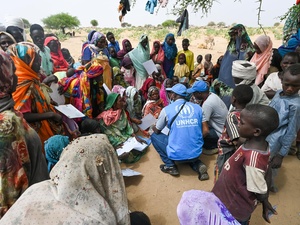Congolese refugees fleeing to South Sudan
Congolese refugees fleeing to South Sudan
Recent attacks by the so-called Lord's Resistance Army in north-eastern Democratic Republic of the Congo (DRC) have driven thousands of Congolese to South Sudan. Over the week end, a UNHCR team went to the South Sudan village of Lasu, 50 km from the DRC border, after receiving reports by local authorities of new arrivals. Our team registered 680 people, most of them from the DRC village of Aba. They said they fled their homes following a LRA attack last week.
The number of refugees in Lasu is actually estimated at up to 2,000 and we are continuing verification. Our team found out that many parents had gone back to the DRC to search for food for their children. Many of the children had gone several days without eating. Most of the refugee population in Lasu is living in the open, under trees. They are relying largely on the generosity of the local population, but far outnumber the local residents, who have only limited food stocks. The World Food Programme is dispatching a one-food month ration today from Juba, while UNHCR is reviewing emergency assistance to the refugees.
Over the weekend, one of our teams was also in Ezo, further to the west toward the border with the Central African Republic and the DRC. Some 2,000 Congolese refugees arrived there some weeks ago following LRA attacks north-west of Dungu. All refugees are accommodated in huts in Napere, a spontaneous camp located 2 km north of Ezo. The lack of food is also a serious problem in the Ezo area, which previously received many of its supplies from the DRC. The local community is unable to support the refugees, who are compelled to seek food in the wild. WFP plans to send food from Juba today. Children are showing signs of malnourishment. Lack of clean water, drugs and medical care are also affecting the refugees.
Humanitarian assistance remains hampered by the volatile security situation in this area as well as by the limited accessibility. The airstrip in Ezo is not operational and roads are only usable during the dry season. Although South Sudan is in the dry season at the moment, there have been heavy rains in Western and Central Equatoria in recent days. There are also many thousands of Sudanese displaced people in Western Equatoria as a result of LRA attacks within Southern Sudan.
In another development, we are continuing the transfer of refugees from the Gangura and Yambio areas in South Sudan, near the DRC border, to Makpandu site, 44 km north-east of Yambio. To date, we have transported 822 people. These refugees are part of a larger group of over 6,000 people who escaped LRA attacks on their villages near Dungu, in north-east DRC, last September.








